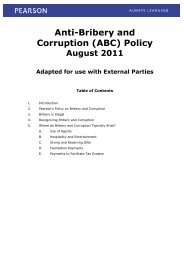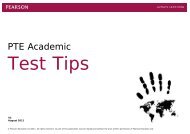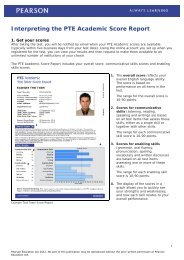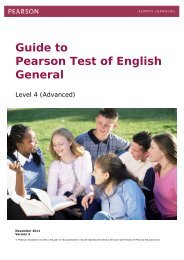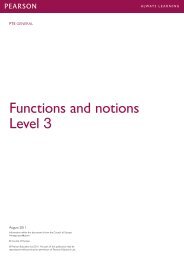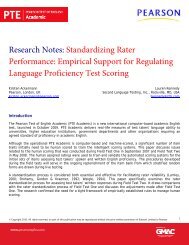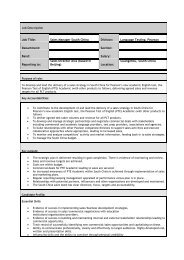Versant English Test: Test Description and Validation Summary
Versant English Test: Test Description and Validation Summary
Versant English Test: Test Description and Validation Summary
Create successful ePaper yourself
Turn your PDF publications into a flip-book with our unique Google optimized e-Paper software.
example below.<br />
Examples:<br />
1. Traffic is a huge problem in Southern California.<br />
2. The endless city has no coherent mass transit system.<br />
3. Sharing rides was going to be the solution to rush-hour traffic.<br />
4. Most people still want to drive their own cars, though.<br />
Presenting the sentences in a group helps the test taker disambiguate words in context <strong>and</strong> helps<br />
suggest how each individual sentence should be read aloud. The test paper or computer screen<br />
presents three sets of four sentences <strong>and</strong> asks the test taker to read eight of these sentences in a<br />
r<strong>and</strong>om order. The system tells the test taker which of the numbered sentences to read aloud. After<br />
the system hears the end of one sentence, it prompts the test taker to read another sentence from<br />
the list.<br />
The sentences are relatively simple in structure <strong>and</strong> vocabulary, so they can be read easily <strong>and</strong><br />
in a fluent manner by literate speakers of <strong>English</strong>. For test takers with little facility in spoken <strong>English</strong><br />
but with some reading skills, this task provides samples of their pronunciation <strong>and</strong> reading fluency.<br />
The readings start the test because, for many test takers, reading aloud presents a familiar task <strong>and</strong><br />
is a comfortable introduction to the interactive mode of the test as a whole.<br />
Part B: Repeat<br />
In this task, test takers repeat sentences verbatim. The sentences are presented to the test taker<br />
in approximate order of increasing difficulty. Sentences range in length from 3 words to 15 words.<br />
The audio item prompts are read in a colloquial manner.<br />
Examples:<br />
Biology requires study.<br />
It’s supposed to rain tomorrow, isn’t it?<br />
There are three basic ways in which a story might be told to someone.<br />
To repeat a sentence longer than about seven syllables, the test taker has to recognize the<br />
words as spoken in a continuous stream of speech (Miller & Isard, 1963). Highly proficient speakers<br />
of <strong>English</strong> can generally repeat sentences that contain many more than seven syllables because<br />
these speakers are very familiar with <strong>English</strong> words, phrase structures, <strong>and</strong> other common syntactic<br />
forms. If a person habitually processes five-word phrases as a unit (e.g. “her really big apple tree”),<br />
then that person can usually repeat utterances of 15 or 20 words in length. Generally, the ability to<br />
repeat material is constrained by the size of the linguistic unit that a person can process in an<br />
automatic or nearly automatic fashion. As the sentences increase in length <strong>and</strong> complexity, the task<br />
becomes increasingly difficult for speakers who are not familiar with <strong>English</strong> sentence structure.<br />
Because the Repeat items require test takers to organize speech into linguistic units, it tests their<br />
sentence mastery. In addition, the task has them repeat back full sentences (as opposed to just<br />
words <strong>and</strong> phrases), <strong>and</strong> therefore, it also offers a sample of the test taker’s pronunciation <strong>and</strong><br />
fluency in spoken <strong>English</strong>.<br />
Pearson now includes Ordinate products <strong>and</strong> services. Page 4 of 28<br />
© 2008 Pearson Education, Inc. or its affiliate(s). All rights reserved. Ordinate <strong>and</strong> <strong>Versant</strong> are trademarks, in the U.S. <strong>and</strong>/or<br />
other countries, of Pearson Education, Inc. or its affiliate(s). Other names may be the trademarks of their respective owners.




